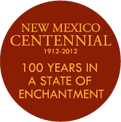« Running With Numbers | Main | New Officers: DPNM »
Sunday, April 29, 2007
Guest Blog: National Conservation Area Proposed for Taos County
This is a guest blog by Jim O’Donnell, Northern Director, New Mexico Wilderness Alliance:
One of the wildest places in New Mexico can be found in Taos County.
The area is massive, sprawling over more than 300,000 acres. How you name it depends on who you talk to. I label it by a group of individual names: Rio Grande Gorge, Ute Mountain, Sunshine Valley, Wild Rivers, Cerro de la Olla, Cerro Chiflo, Rio San Antonio, Cerro del Aire...other names are Windmill, the Punche Valley, el llano, Upper Gorge, Lower Gorge, Rio Grande Corridor, the Ute Mountain Run...the challenge in naming it has all to do with its size and diversity – as does the challenge in describing it.
So, lets begin with the river.
The Labatos Bridge marks the beginning of the Rio Grande Gorge. The bridge can be found in Colorado where the Rio Grande begins its cut into the Servilleta lava flows that make up the Taos Plateau. Eight miles later, at the New Mexico state line, the river is 200 feet down, the gorge 150 feet across. West of Questa, where Big Arsenic Spring bubbles from the rock and pinyon jays heap in the winter, the river is a glinting green ribbon eight hundred feet down. The opposite rim is over half a mile away where, on summer mornings, bald eagles soar southward in pairs. At John Dunn Bridge the river enters The Box, an 18-mile stretch of 900 foot cliffs, famous among boaters.
This is also the Rio Grande Migratory Flyway – one of the great migratory routes in the world. Eagles, falcons and hawks make the basalt walls of the Gorge their nesting homes. Ospreys, scaups, hummingbirds, herons, avocets, merlins and willits all traverse the Gorge. The sound of Sandhill Cranes migrating from the San Luis Valley to places like Bosque Del Apache can be deafening while on an October hike in the tablelands west of the river.
It’s that western plateau that is perhaps the most wild. From the edge of the Gorge, vast grass and sagebrush mesas intersperse with the forested slopes of volcanic intrusions such as Cerro Chiflo, Cerro del Aire, Montosos and Cerro de la Olla. It is on these mesas where vast herds of pronghorn and elk find winter forage and calve and fawn along the rim late in the spring. A rancher swore to me he’d heard a wolf howl out there just a few years ago.
This substantial chunk of wild is bounded by the Gorge Rim on the east and Highway 285 on the west. The northern portion spills over 285, encompassing the broad, gently rolling grass and sage brush plains of the Rio San Antonio Gorge WSA, bisected by yet another gorge where raptors next in 200-foot high lava walls and conifers clamber down to the Rio los Pinos.
Perhaps the crown jewel of this whole area is Ute Mountain, a 10,093 foot high volcanic cone rising nearly 3,000 feet above the surrounding plain. Ute is something you can’t miss. Located about ten miles west of Costilla, it is the dominate feature for those driving north from Taos along highway 522.
The steep slopes of Ute are covered in pinyon at the base, as well as pockets of ponderosa, aspen, white pine and Douglas Fir in the higher elevations. From grassy meadows of blue grama, western wheatgrass and Indian ricegrass where the trees thin, the Gorge is a jagged, inky slash dividing Ute from its sister cones to the west. Snow-capped Blanca rises to the north, just across the state line. The whole Sangre de Cristo range falls to the east, terminating, view-wise, at Wheeler Peak. There are people here too. Lupe, Bobby, Esther, Rudy, Ron, Dennis....
Descendants of the land grantees run cattle all along the Gorge and out into the table-lands between the rim and Highway 285. Vehicle routes tend towards sparse and are more likely than not unmaintained two-tracks. Hunting and fishing are common. Hikers climb to the bottom of the gorge for a swim and a picnic. The Box is a popular rafting area and bird watching draws – well, not as many as it ought to. Its fabulous birding! On the slopes of Cerro de la Olla, locals collect firewood to heat their homes in the winter.
This is wild land, important to the culture and character of our county and vital, in its wildness, to our economy. We learned two main lessons during the battles over the Valle Vidal: one, no chunk of public land is secure from mineral development or other forms of exploitation – no matter how safe you may think that land is, no matter how ‘lacking’ in exploitative possibilities it may be, someone, sometime is going to come after that land. Our other lesson was this: our economy in north-central New Mexico is dependant on Wilderness. Wilderness feeds the rivers that feed the acequias. It nurtures our rural lifestyle. Wilderness is the ‘bank’ from which we hunt and fish. It is also a tremendous economic development opportunity. Perhaps most importantly, these wildlands create and nurture the character of the people of Taos County. The Bureau of Land Mangement (BLM) manages the whole thing. This is public land. Our land.
It is invaluable.
For over a year now, the New Mexico Wilderness Alliance has been in discussion with the BLM and Senator Bingaman’s office to find a way to give this massive area the protection it deserves. We have wide-ranging support on this effort from the ranching community, the local elected officials, the acequias, the sportsmen community, the boaters and the biologists.
Any day now, Senator Bingaman will introduce legislation to assure the wild character of this land through a National Conservation Area (NCA) designation. The highlights of this legislation will be the placement of Ute Mountain and the Rio San Antonio Gorge within the Wilderness system.
The goals of this legislation are clear. We want to preserve the rural character of Taos County. We want to protect and encourage traditional uses of the area such as ranching, hunting, fishing and wood-gathering. Private lands within the boundaries would not be affected in any way. Restrictions on development of private lands will remain subject to local/county ordinances.
With this legislation, we seek to ensure a vibrant economic future that values our natural, scenic and cultural resources.
Most Taosenos seek a new vision for economic sustainability that relies on local agriculture, renewable energy, green building and small business. The NCA would support this kind of economic future.
WHAT YOU CAN DO
- Call Senator Bingaman and thank him for this magnificent effort: 505-224-5521
- Call AND write to Senator Domenici’s office. Tell the Senator that you just heard about the Taos County National Conservation Area (NCA) proposal and that you would like for him to co-sponsor the bill from the moment it is introduced. Be sure to follow up your call with a letter. SORRY I DO NOT HAVE A BILL NUMBER YET. Call 202-224-6621, Senator Pete V. Domenici, 328 Hart Senate Office Building, Washington, DC 20510-3101
- Write to one or all of the three newspapers below. Express your support for Senator Bingaman’s Taos County NCA proposal - even if you are from out of state. Be sure to include your name, location and day time phone number.
- Taos News: forum@taosnews.com
- Santa Fe New Mexican: letters@sfnewmexican.com
- Albuquerque Journal: opinion@abqjournal.com
Talking Points
Feel free to include any of your own observations or experiences in the area if you have been there.
- The proposed NCA includes some of the most spectacular scenery in all of New Mexico;
- Existing uses, such as ranching, hunting, fishing and rafting would not be impacted by the creation of the NCA. In fact, those uses would be protected and encouraged;
- The establishment of the proposed NCA and associated Wilderness will provide for future generations of New Mexicans continuing opportunities to enjoy the recreational opportunities to hunt, fish, observe wildlife, and experience solitude;
- Creation of the NCA and Wilderness areas would give local communities a natural attraction and resource to use as part of a long-term sustainable economic development plan;
- The NCA would help protect and ensure valuable water resources;
- The rights of private land owners within the NCA boundaries will be respected if they choose to not trade their land.
--------
Thanks for your help all! We tried to get something similair done nearly twenty years ago when Richardson was our Congressman but, for a number of reasons, it didnt work out. If we dont get it this time, it will be another twenty years before we'll have another chance.
THANK YOU
Crossposted from UNBOSSED.
Editor's Note: This is a guest blog by Jim O’Donnell, Northern Director, New Mexico Wilderness Alliance. Jim has agreed to contribute occasional guest posts here at DFNM. If you'd like to submit a guest post for consideration, contact me by clicking on the Email Me link at the upper left-hand corner of the page.
April 29, 2007 at 06:02 AM in Environment, Guest Blogger | Permalink


















